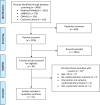Effectiveness and characteristics of physical fitness training on aerobic fitness in vulnerable older adults: an umbrella review of systematic reviews
- PMID: 35641014
- PMCID: PMC9157351
- DOI: 10.1136/bmjopen-2021-058056
Effectiveness and characteristics of physical fitness training on aerobic fitness in vulnerable older adults: an umbrella review of systematic reviews
Abstract
Objectives: To present an overview of effectiveness and training characteristics of physical training on aerobic fitness, compared with alternative or no training, in adults aged over 65 years with various health statuses, providing a basis for guidelines for aerobic training of vulnerable older adults that can be used in geriatric rehabilitation.
Design: An umbrella review of systematic reviews that included both randomised controlled trials and other types of trials.
Data sources: MEDLINE, Embase, CINAHL and the Cochrane Library were searched on 9 September 2019.
Eligibility criteria for selecting studies: We included systematic reviews reporting on physical training interventions that are expected to improve aerobic fitness, presenting results for adults aged 65 years and older, describing at least one of the FITT-characteristics: Frequency, Intensity, Time or Type of exercise, and measuring aerobic fitness at least before and after the intervention.
Data extraction and synthesis: Two independent reviewers extracted the data and assessed the risk of bias. A narrative synthesis was performed.
Results: We included 51 papers on 49 reviews. Positive effect of training on aerobic fitness was reported by 33 reviews, 11 reviews remained inconclusive and 5 reviews reported no effect. Training characteristics varied largely. Frequency: 1-35 sessions/week, Intensity: light-vigorous, Time: <10-120 min/session and Types of exercise: many. The methodological quality was most often low. Subgroup analyses revealed positive effects for all health conditions except for trauma patients. Exercise characteristics from current existing guidelines are widely applicable. For vulnerable older adults, lower intensities and lower frequencies were beneficial. Some health conditions require specific adjustments. Information on adverse events was often lacking, but their occurrence seemed rare.
Conclusion: Physical fitness training can be effective for vulnerable older adults. Exercise characteristics from current existing guidelines are widely applicable, although lower frequencies and intensities are also beneficial. For some conditions, adjustments are advised.
Prospero registration number: CRD42020140575.
Keywords: clinical physiology; geriatric medicine; rehabilitation medicine.
© Author(s) (or their employer(s)) 2022. Re-use permitted under CC BY-NC. No commercial re-use. See rights and permissions. Published by BMJ.
Conflict of interest statement
Competing interests: None declared.
Figures
Similar articles
-
Overview of Systematic Reviews of Aerobic Fitness and Muscle Strength Training after Spinal Cord Injury.J Neurotrauma. 2019 Nov 1;36(21):2943-2963. doi: 10.1089/neu.2018.6310. Epub 2019 May 23. J Neurotrauma. 2019. PMID: 30982398
-
Behavioural modification interventions for medically unexplained symptoms in primary care: systematic reviews and economic evaluation.Health Technol Assess. 2020 Sep;24(46):1-490. doi: 10.3310/hta24460. Health Technol Assess. 2020. PMID: 32975190 Free PMC article.
-
High-intensity interval training and cardiorespiratory fitness in adults: An umbrella review of systematic reviews and meta-analyses.Scand J Med Sci Sports. 2024 May;34(5):e14652. doi: 10.1111/sms.14652. Scand J Med Sci Sports. 2024. PMID: 38760916
-
Effectiveness of exercise interventions on physical function in community-dwelling frail older people: an umbrella review of systematic reviews.JBI Database System Rev Implement Rep. 2018 Mar;16(3):752-775. doi: 10.11124/JBISRIR-2017-003551. JBI Database System Rev Implement Rep. 2018. PMID: 29521871
-
Effects of Concurrent Strength and Endurance Training on Measures of Physical Fitness in Healthy Middle-Aged and Older Adults: A Systematic Review with Meta-Analysis.Sports Med. 2023 Feb;53(2):437-455. doi: 10.1007/s40279-022-01764-2. Epub 2022 Oct 12. Sports Med. 2023. PMID: 36222981 Free PMC article.
Cited by
-
Exercise testing and training in frail older adults with an orthopedic impairment participating in a geriatric rehabilitation program: an international Delphi study.Eur Geriatr Med. 2023 Oct;14(5):985-997. doi: 10.1007/s41999-023-00819-5. Epub 2023 Jul 4. Eur Geriatr Med. 2023. PMID: 37400662 Free PMC article.
-
Clinical-Functional Vulnerability, Functional Capacity, and Falls in Octogenarians with Different Physical Activity Levels-A Cross-Sectional Study.Int J Environ Res Public Health. 2022 Sep 21;19(19):11909. doi: 10.3390/ijerph191911909. Int J Environ Res Public Health. 2022. PMID: 36231209 Free PMC article.
-
Cross-sectional insights into exercise physiology knowledge among medical students in Jordan.SAGE Open Med. 2024 Jan 25;12:20503121241226608. doi: 10.1177/20503121241226608. eCollection 2024. SAGE Open Med. 2024. PMID: 38283645 Free PMC article.
References
Publication types
MeSH terms
LinkOut - more resources
Full Text Sources
Medical

